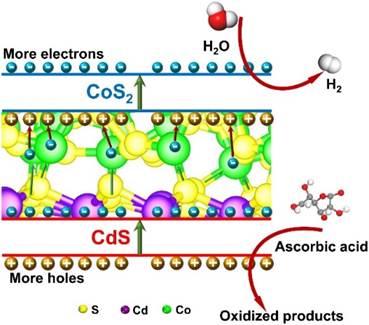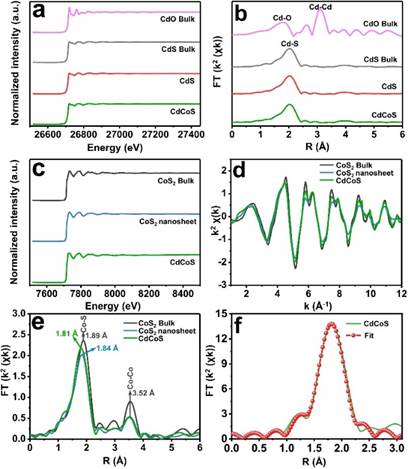| Unravelling the Interfacial Charge Migration Pathway at Atomic Level in a Highly Efficient Z-scheme Photocatalyst |
| From: PublishDate:2020-07-29 Hits: |
Until now, huge achievements on direct Z-scheme photocatalysts have been made towards various photocatalytic applications due to the super efficiency by promoting the separation of photoinduced electron-hole pairs and maximizing the redox potential. However, the development of direct Z-scheme photocatalysts is still at an early stage and most of the Z-scheme photocatalytic systems have been developed in a trial-and-error manner, as there is a major lack of knowledge and understanding about migration pathway of photogenerated electron-hole pairs between two components at atomic level (interfacial atomic structure and its corresponding electronic states). The research team of the college of Environmental Science and Engineering of Nankai University conducted in-depth exploration on it, rationally designed a new Z-type photocatalyst and analyzed the interface charge migration path. The related research was published in "Angewandte Chemie International Edition" on August 12th, 2019.
The team reported operando spectroscopic evidences and theoretical insights for the photocatalytic activity of Z-scheme CdS/CoS2 photocatalyst. The formation of Co-S5.8 transition layer at the interface can introduce interfacial states and work as the charge migration pathway to transfer electrons from CdS to CoS2. Thus, more photogenerated electrons and holes can participate in the surface photocatalytic reaction. According to transient absorption spectroscopy (TAS), we can estimate a charge separation yield of ~91.5% from CdS to CoS2 and the charge separated state lifetime of ~5.2 ± 0.5 ns. Therefore, under light irradiation, CdS/ CoS2 has higher photocatalytic hydrogen evolution and pollution degradation efficiency than CdS and CoS2. This study goes a step forward to preparing highly efficient Z-scheme photocatalyst and understanding the charge migration pathway in heterojunction photocatalysts. Measurements carried out at 1W1B-XAFS station of Beijing Synchrotron Radiation Facility were used to obtain the quantitative structural parameters. The electronic structure and local atomic arrangement of Cd were studied and the interface microstructure of CdCoS (CdS/ CoS2) was further explored. The spectra of as-synthesized CdS nanowires and CdCoS resemble to each other, with edge position and overall spectral feature nearly identical in to that of bulk CdS. This finding indicates that CdS in CdCoS hybrid has very similar local atomic structure to CdS nanowires, and the CoS2 nanosheets has little impact on the chemical-bonding nature of the CdS component. Co K-edge positions of CoS2 nanosheets and CdCoS are in line with the reference CoS2, suggesting that the local structure around Co atoms in the samples is similar to the Co-S octahedral structure in the bulk CoS2. The Co K-edge k2χ(k) oscillation curves for the CoS2 nanosheet and CdCoS display obvious differences compared with the bulk CoS2. The Co-S peaks of CoS2 nanosheets and CdCoS shift to the low R direction with obviously decreased intensities, qualitatively revealing their distinct local atomic arrangement. Meanwhile, the Co-Co peaks of the three samples show no obvious difference. least-squares curve fitting show that the coordination numbers for Co-S of CoS2 nanosheets reduced remarkably from 6 to 5.1, while that of CdCoS increased from 5.1 to 5.8. Thus, the real transition layer between CdS and CoS2 is obtained.
This research promoted the direct Z-type photocatalyst from experimental exploration to rational design, and explored the basic mechanism of charge transfer kinetics of the Z-type photocatalyst system. The synchrotron radiation light source helped the research group delve into the interface microstructure. Prof. Sihui Zhan, the leader of the research group and the associate dean of the college of environmental Science and Engineering of Nankai University, described their work as follows: “Interface coordination structure and electron migration path still need to be explored in depth. Various experimental technologies of synchrotron radiation will provide a powerful research platform for real-time, in-situ, and dynamic characterization of nanostructures, and play an important role in the characterization of the structure and performance of nanomaterials.” Article: Pengfei Wang, Yueshuang Mao, Lina Li, Zhurui Shen, Xiao Luo, Kaifeng Wu, Pengfei An, Haitao Wang, Lina Su, Yi Li, and Sihui Zhan*. Unraveling the Interfacial Charge Migration Pathway at the Atomic Level in a Highly Efficient Z‐Scheme Photocatalyst, Angew. Chem. Int. Ed., 2019, 58, 11329-11334. |
|
|
| Chinese
- Metal-free efficient photocatalyst for stable visible water splitting——Top ten major scientific progresses in China in 2015
- The nano-resolution imaging platform was awarded the first rate prize of Beijing Science and Technology in 2014
- Beamline 1W1 of BSRF started to runoperate in the couplingparasitic mode of BEPCII
- Synthesis of High Performance Polymer Materials for Field Effect-Transistors
- Surfactant molecular aggregates in green solvents
- GIXRD has played an important role in the characterization of organic thin-film transistors
Copyright © 2011 - 2012 Beijing Synchrotron Radiation Facility



